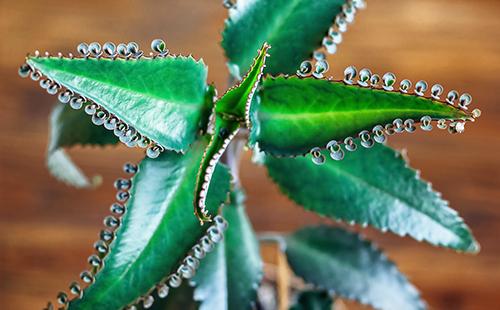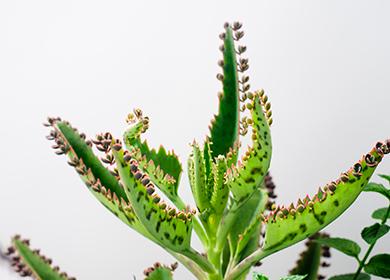The content of the article
"Viviparous" Kalanchoe, capable of independent reproduction. Belongs to succulent plants, differs in simplicity of cultivation and leaving. Adult plants partially lose their decorativeness, they are easily revived by rooting the top.
Plant description
A relatively low plant, not exceeding 50 cm. The botanical name is Degremon's Briofillum. The leaves are narrow, fleshy, in shape resembling an elongated triangle. The tips are pointed, the edges are serrated. The color of the sheet plate on the top and bottom is different. Leaves above are grayish-green, below are green with faded purple spots. The stalk is uneven, adult plants need support.
A feature of this variety of Kalanchoe is the presence of leaf brood buds between the teeth. Of these, numerous children are formed right on the plant - small but already full-fledged plants with a small root system. They fall and root themselves. Other species are not endowed with the ability to form children on leaves or form them in very limited quantities.
Acquisition and care after purchase
Only from a healthy seedling will a beautiful, strong plant grow. Carefully choose Kalanchoe in the store, properly care for it at first, until the flower gets used to the new conditions of detention.
Choose a healthy flower
Almost all the plants in the store look good. The reason is the use of growth stimulants, flowering, special additives. With mass sales, it is impossible to create separate conditions for each flower. Hence the first rule - choose a flower that has gone on sale recently. Feel free to ask the seller about this. Pay attention to other points.
- The soil. Soil should not be dense and too damp. Kalanchoe Degremon does not tolerate waterlogging. In damp, the roots quickly rot.
- Leaves and Stems. The color should be uniform, without spots. The structure is dense, elastic. Shriveled, yellow leaves, dark spots on them, dry edges, softened areas - all this indicates a diseased plant or improper conditions of detention.
- Pests. Inspect the whole plant, look at the underside of the leaves. Small spots, cobwebs, plaques on the stem, sticky drops, plaque are signs of pests.
- Leaf arrangement. A large distance between the leaves on the stem - Kalanchoe was kept in low light conditions. It will be possible to return decorativeness only by rooting the top.
How to meet a “newcomer”
How to care for Kalanchoe degremone after purchase? The task of the grower is to provide an easier adaptation of the flower, to protect it from diseases and pests.
- Quarantine. Any plant after acquisition is quarantined - it is isolated from other indoor flowers. In two weeks of quarantine, you can detect undetected pests in the store or prevent their relocation to Kalanchoe from other domestic flowers.
- Lighting. Keep in moderate light in a slightly shaded area. In the sun, Kalanchoe will be more difficult to adapt to new conditions of detention. The sun is taught gradually.
- Transfer. Assess the condition of the soil. If it is dense, with signs of mold, plaque, Kalanchoe should be transplanted immediately into suitable soil.
- Top dressing. The first month of fertilizer is not applied. To maintain decorativeness in stores, flowers are generously watered with growth stimulants. You can feed only a month after transplanting from the shipping container.
After quarantine, Kalanchoe can be put to the rest of the flowers, switch to another care regime taking into account the characteristics of the plant.
Care for Kalanchoe Degremon: what to consider
Growing Kalanchoe Degremon in a pot does not require special skills. Kalanchoe will grow well even with beginners. This is a very tenacious plant. In adverse conditions, it does not die, just loses its decorative effect. Recommended to stick
- Lighting. Kalanchoe Degremona is demanding of light. They create a good level of lighting, but in the summer they protect them from direct sun. In winter you can keep it on the south side.
- Temperature. The optimum temperature for growth is 17-19 ° C. Extreme heat or cold negatively affects the condition of the leaves, the root system, and the appearance of Kalanchoe.
- Watering. Water Kalanchoe Degremon better moderately, limited portions of water. In spring and summer, they water more and more often, in the fall they limit watering, in winter they minimize it. The frequency of watering depends on the temperature in the room. The cooler the less water you need. Water is used, it is poured, it is poured into a tray - water should not get on the stems and leaves.
- Humidity. Kalanchoe - a succulent plant, accumulates in the leaves a supply of moisture in case of drought. Artificial humidity does not increase. Periodic spraying and bathing in the shower is used only for hygienic purposes. After water procedures, the leaves and sinuses of the leaves are wiped with a dry soft cloth.
- The soil. Ready-made primers for succulents are suitable. The main qualities of the soil are friability, lightness, water permeability. Independently, soil with similar characteristics is prepared from turf, sand, rotted humus and gravel crumbs. It is useful to add some crushed birch coal. A drainage layer is required!
- Transfer. Up to three years, plants are transplanted every year. The pot each time take 1-2 cm more in diameter of the previous one. Further transplants as the root system grows. If the small roots began to peek through the drainage holes, it is time to transplant Degremont's Kalanchoe. In large plants that have lost their decorativeness, the top is cut off and rooted.
- Top dressing. Fertilizers for succulents are applied only in the warm season - from mid-spring to mid-autumn. Frequency of top dressing - once a month.
3 ways to breed
Reproduction of Kalanchoe Degremon - a simple and exciting process. Parts of leaves and stems easily take root, give life to new plants. Get seeds at home fails. Three methods of vegetative propagation are used.
- Kids. Natural, natural method of propagation of Kalanchoe degremone. Between the cloves of leaves from brood buds tiny babies form. They let the roots fall, and root. You can wait a bit until they get stronger and put them in separate pots. They do not need to be kept under cover. The only requirement is to maintain stable moisture on the soil surface.
- Apical shoots. Small apical cuttings are cut, the lower leaves are cut. Root directly in light soil. The soil is systematically watered as the top layer dries.
- Leaf. Stem leaves and even parts of leaves are capable of rooting. The leaf is carefully cut and simply laid on moist ground. The first few days can be held under the film, but make sure that condensation does not accumulate. Very soon, children will appear on the leaf.
Growing problems
Kalanchoe does not die even in very adverse conditions, but decorative loses easily. By the appearance of the plant, you can understand that he lacks - moisture, light, nutrients. Common problems and their causes are shown in the table.
Table - Problems in growing Kalanchoe degremone and their causes
| Problem | The reasons |
|---|---|
| Kalanchoe Degremon leaves fall | - Improper maintenance in the winter; - close proximity to heating appliances; - low temperatures combined with high humidity |
| Leaves turn yellow | - Exhaustion, transplant recommended; - lack of moisture |
| The leaf dries at the tips | - Boron deficiency |
| Leaves curl | - Damage to the root system; - too lit place |
| Kalanchoe wilts | - lack of moisture; - rotting of the roots; - irregular watering; - natural aging |
| Black spots appear | - Fungal disease |
| Brown spots appear | - Waterlogging in combination with temperature differences |
| White plaque appears on the leaves | - Hard water with an excess of salts and lime |
| Leaves hanging | - Subcooling |
| Does not bloom | - Flowering for Kalanchoe Degremon in an apartment environment is not typical |
| Stretched out | - lack of light |
| Leaves are fading | - lack of light; - lack of nutrients |
| Holes appear on the leaves | - pests; - sunburn after spraying |
If fungal diseases are suspected, treatment is carried out with systemic fungicides. Combine watering the soil with spraying. In most cases, a transplant is required with the removal of damaged fragments of the root system. Of the fungicides, Phytosporin, Rovral, Topaz, and Chistotsvet are most often used.

Common pests
Kalanchoe pests rarely infect, but this possibility cannot be ruled out. Timely recognition of pests and start the fight against them will help the information from the table.
Table - The main pests of Kalanchoe Degremon
| Insect | Signs | Ways to fight |
|---|---|---|
| Aphid | - Sticky coating; - twisting of young shoots and leaves; - colonies of small green insects | - Washing with soapy water; - spraying with tobacco dust infusion; - spraying with insecticides |
| Shield | - Brown, reddish plaques on the stems and leaves; - sticky drops on the stems; - wilting plants | - Mechanical removal of insects; - washing with soapy water; - repeated treatment with fungicides |
| Root worm | - Withering Kalanchoe for no apparent reason | - transplantation; - treatment of the root system with fungicides; - replacement of soil and pot; - decrease in watering frequency |
| Spider mite | - Small yellow dots on the leaves; - thin web on the back of the sheet; - yellowing of leaves | - Increase in air humidity; - insecticide treatment |
The most effective insecticides are Fitoverm, Akarin, Actellik, Inta-Vir. With a slight lesion, a single treatment is enough, with a massive resettlement of insects it is necessary to process up to three times.
Caring for Kalanchoe Degremon takes a minimum of time. The plant combines high decorative qualities and healing properties. This explains the widespread occurrence of Kalanchoe as a houseplant.

